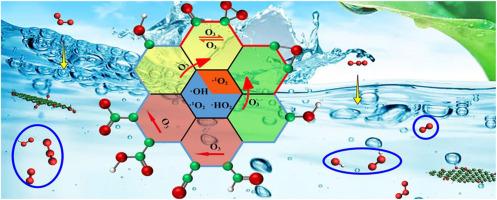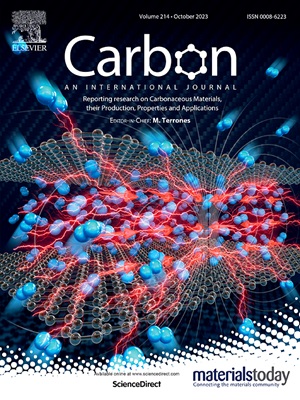Probing the formation mechanisms of reactive oxygen species in graphene oxide-catalyzed ozone advanced oxidation processes
IF 10.5
2区 材料科学
Q1 CHEMISTRY, PHYSICAL
引用次数: 0
Abstract
Graphene oxide (GO), a representative carbon-based catalyst, has demonstrated promising prospects for oxidation removal of organic pollutants in ozone (O3)-based advanced oxidation processes (AOPs). However, due to complex reactions of realistic ozonation processes, the functional mechanisms of oxygen-containing functional groups of GOs remain ambiguous, which are generally difficult to identify by single experimental characterization. Herein, we applied density functional theory (DFT) to investigate the physical interactions and chemical reaction mechanisms between O3 and oxygen-containing functional groups of GO in aqueous media. It is demonstrated that the functional groups on GOs could promote the generation of various reactive oxygen species (ROS) through different ozonation mechanisms, which include direct activation and indirect H-abstraction. The connection between types of functional groups and the generated ROS has been established. Further reactive molecular dynamics simulations were used to dynamically capture the catalytic ozonation events for the functional groups of GOs. The simulated type changes of functional groups and time evolution of the ROS-related species number show consistent behavior with the above DFT computations. The proposed mechanisms provide an improved understanding of ozonation catalysis, which is expected to advance the development of AOP technologies utilizing GO catalysis.

探索氧化石墨烯催化臭氧深度氧化过程中活性氧的形成机制
氧化石墨烯(GO)是一种代表性的碳基催化剂,在臭氧(O3)基高级氧化工艺(AOPs)中被证明具有良好的氧化去除有机污染物的前景。然而,由于实际臭氧化过程的复杂反应,氧化石墨烯含氧官能团的作用机制尚不明确,一般难以通过单一的实验表征来确定。本文应用密度泛函理论(DFT)研究了水中氧化石墨烯中O3与含氧官能团之间的物理相互作用和化学反应机理。结果表明,氧化石墨烯上的官能团可以通过直接活化和间接抽氢等不同的臭氧化机制促进多种活性氧(ROS)的生成。功能基团类型与生成的活性氧之间的联系已经建立。进一步的反应分子动力学模拟用于动态捕捉氧化石墨烯官能团的催化臭氧化事件。模拟的官能团类型变化和ros相关物种数量的时间演化与上述DFT计算结果一致。提出的机制提供了对臭氧化催化的更好理解,这有望推动利用氧化石墨烯催化的AOP技术的发展。
本文章由计算机程序翻译,如有差异,请以英文原文为准。
求助全文
约1分钟内获得全文
求助全文
来源期刊

Carbon
工程技术-材料科学:综合
CiteScore
20.80
自引率
7.30%
发文量
0
审稿时长
23 days
期刊介绍:
The journal Carbon is an international multidisciplinary forum for communicating scientific advances in the field of carbon materials. It reports new findings related to the formation, structure, properties, behaviors, and technological applications of carbons. Carbons are a broad class of ordered or disordered solid phases composed primarily of elemental carbon, including but not limited to carbon black, carbon fibers and filaments, carbon nanotubes, diamond and diamond-like carbon, fullerenes, glassy carbon, graphite, graphene, graphene-oxide, porous carbons, pyrolytic carbon, and other sp2 and non-sp2 hybridized carbon systems. Carbon is the companion title to the open access journal Carbon Trends. Relevant application areas for carbon materials include biology and medicine, catalysis, electronic, optoelectronic, spintronic, high-frequency, and photonic devices, energy storage and conversion systems, environmental applications and water treatment, smart materials and systems, and structural and thermal applications.
 求助内容:
求助内容: 应助结果提醒方式:
应助结果提醒方式:


